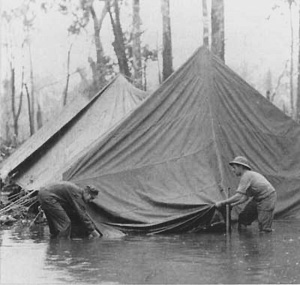![]() The Pacific War Online Encyclopedia
The Pacific War Online Encyclopedia
|
| Previous: Mononobe Choho | Table of Contents | Next: Montgomery, Alfred E. |

U.S. Marine Corps #72463.
Via ibiblio.org
A monsoon is a prevailing wind pattern that reverses direction every six months, and typically brings dry weather half the year and wet weather the other half. It is a common feature of climate in the subtropics. The monsoon is caused by seasonal heating and cooling of a nearby continental land mass. During the winter months, the continental land surface receives less sunlight and cools off, cooling the air above it. This cool, dry air sinks, flowing from the center of the continent towards its coasts and beyond. During the summer, the continental land surface receives more sunlight and heats up, heating the air above it. This warm air rises, drawing in moist air from the surrounding oceans.
Thus, the summer monsoon usually brings very wet weather, while the winter monsoon typically brings dry weather. However, local geography can modify this pattern. For example, most of the Indian subcontinent experiences its wet season during the summer monsoon, but portions of the southeast Indian coast experience their wet season during the winter monsoon, because the wind from the Asian landmass crosses the Bay of Bengal and picks up considerable moisture. For similar reasons, the north coast of Java and the coast of northern Vietnam experience their wet season during winter in the Northern Hemisphere.
Most people associate the monsoon with torrential rainfall. This is certainly true in the foothills of the Himalayas, where the summer monsoon can drop hundreds of inches of rainfall in just two months. However, the dry valleys of the American Southwest experience a summer monsoon which brings less than 10”(25 cm) of rainfall in a typical year, though this is most of the annual precipitation.
Monsoon forests differ from tropical rain forests in the variability of rainfall. During the wet season, a monsoon forest superficially resembles a tropical rain forest, and American troops described both as jungle. During the dry season, however, humidity is relatively low and temperatures can become scorching. Securing an adequate supply of water can be a serious concern. Some of the vegetation of monsoon forests is deciduous, losing its leaves during the dry season to conserve moisture, while the remaining vegetation shows other adaptions to periodic dry conditions such as thick tissues suitable for storing water.
Troop movement in monsoon forests was easiest during the dry season, in spite of the heat and problems with supplying sufficient water. Dust from the dry soil surface was another great nuisance. During the wet season, and depending on the terrain, movement could be nearly impossible due to mud and swollen creeks and rivers. However, the upper reaches of several of the rivers of southeast Asia, including the Brahmaputra and the Irrawady, were navigable only during the wet season.
The monsoon forests of Burma were second only to the rain forests of the South Pacific
as hostile environments for military operations. Webster (2003)
interviewed a Japanese veteran, Oda Atsumi, who claimed that several
Japanese soldiers from his transport unit were killed and eaten by
tigers during his three years in Burma. Like jungle, the monsoon forest
was host to leeches that drained the blood of their victims and could
leave a badly infected sore when they were detached.
References
The Pacific War Online Encyclopedia © 2006-2007, 2010, 2014 by Kent G. Budge. Index